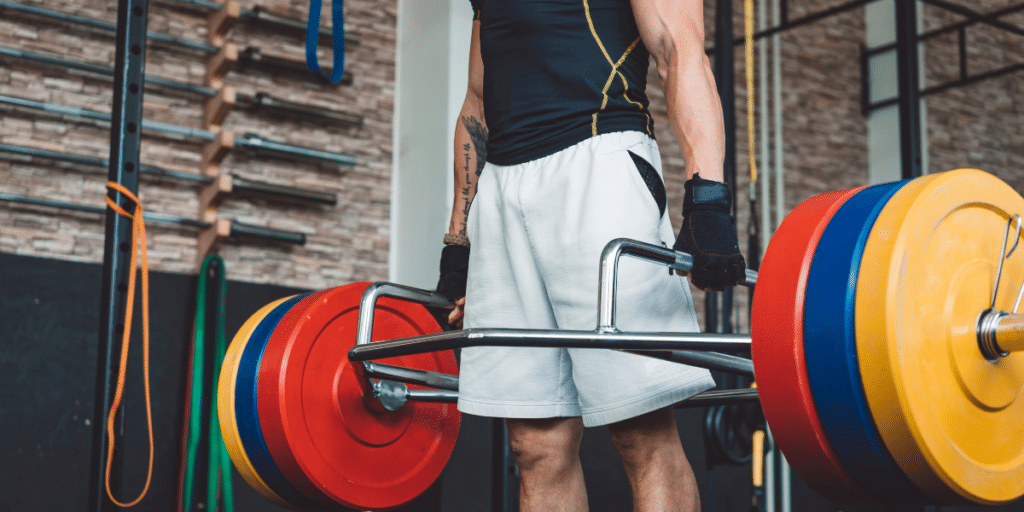The deadlift is one of the most effective exercises you can do. It’s widely seen as the king of compound exercises because it improves grip strength, core strength, athletic performance, overall strength and it trains the largest muscle groups in the body, including the…
- Back
- Legs
- Glutes
- Hamstrings
- Core
The benefits of resistance training are well known, so today we’re going to focus on the benefits of deadlifts. We’ll look at the science behind the movement and how deadlifting with proper form through a full range of motion helps to improve multiple aspects of your health.
Jump to:
What do deadlifts do to your body?
We know that deadlifts have a number of benefits, but what exactly are they?
- Increased strength. Deadlifts are one of the best exercises for increasing overall strength. They help you lift heavier weights, which can improve your performance in other exercises and activities.
- Increased muscle mass. Deadlifts are also great for building muscle mass. They work a large number of muscles, which helps you pack on size. Research published in 2023 shows how deadlifts can help pack on muscle as part of a strength training program.
- Improved posture. Deadlifts can help improve your posture by strengthening your core and back muscles. This can help you stand up straighter and reduce back pain.
- Burned calories. When programmed to be so, deadlifts are a calorie-burning exercise. They can help you burn fat and lose weight as part of a fat-loss specific program.
- Reduced back pain. Research published in the Journal of Strength and Conditioning Research from 2015 showed that ‘studies have indicated that the deadlift exercise may be effective in decreasing pain intensity and increasing activity for most, but not all, patients with a dominating pattern of mechanical low back pain.’
Can deadlifts be used to build muscle?
Yes. They’re an excellent addition to a muscle building workout routine.
The conventional deadlift is a staple exercise of most resistance training programs. They’re a perfect exercise for lifting a heavy weight, which is a precursor for muscle growth. Compound movements such as the deadlift work multiple muscle groups at the same time. This makes them an efficient way to build muscle mass.
The movement uses both the upper body and legs, building muscle across the whole body. The thigh muscles in particular are stimulated to grow when you use proper deadlift form.
How can deadlifts be used to burn fat?
Any fat burning workout has to focus on maximizing calorie burn. This means we change the exercise programming to increase metabolic rate by upping the level of intensity.
Deadlifts can be used to burn fat by lifting lighter weights with a higher frequency, and keeping the rest periods between sets shorter. By adding these changes, rather than focussing on pure weight, the traditional deadlift becomes more of a calorie-burning exercise than a strength building exercise.
This means they can help you create a larger calorie deficit, leading to accelerated fat loss.
Are deadlifts better than squats?
Deadlifts and squats are both great exercises for building strength and muscle mass. However, they work different muscle groups.
Deadlifts focus more work the posterior chain, while squats emphasize the anterior chain. This means that deadlifts are a good way to balance out your training and hit all of your major muscle groups. They’re both excellent exercises.
In a comparison study titled ‘A Comparison Between the Squat and the Deadlift for Lower Body Strength and Power Training‘ from 2020, the researchers concluded that…
‘Results indicate that both the squat and the deadlift can result in similar improvement in lower body maximal strength and jump performance and can be successfully included in strength training programs.’
So no, deadlifts are not better than squats. They’re different, but equally as good!
Deadlift variations to achieve different goals
There are a number of different deadlift variations that you can do to achieve different goals. For example, if you want to focus on building your back muscles, you can do Romanian deadlifts. If you want to focus on building your hamstrings, you can do stiff-leg deadlifts. And if you want to focus on building your glutes, you can do sumo deadlifts.
There’s also adjustments you can make with your starting position. Deficit deadlifts are a good example, where your lower starting position relies on more leg strength to drive the bar up.
Trap/Hex bar deadlifts
Another effective deadlift variation is the hex bar deadlift (very similar to the hex squat). It’s different to the regular deadlifts in that there’s a neutral grip and an adjustment in the muscle firing patterns.
The weight is distributed at either side of the body, rather than in front like with the conventional barbell deadlift. This means the legs, lower back and core muscles work together more. The hex bar deadlift allows you to lift a heavier weight.
The high handle trap bar deadlift allows you to start from a tall position, which helps people who suffer from back problems to deadlift safely.

Stiff leg deadlifts
Stiff leg deadlifts are a variation of the deadlift that you do with straighter legs. This variation focuses on working the hamstring muscles and lower back. It’s a very effective deadlift pattern and helps to strengthen the posterior chain.
The stiff leg deadlift is often used as an accessory exercise in a larger deadlift program, and is performed with a lighter weight because it has a reduced amount of muscle involvement relative to the other forms of deadlift (no quad engagement).
Thanks to the lack of quad engagement, and the targeting of one single rear thigh muscle (the hamstrings), you can still get a great training effect even with reduced weight.
Sumo deadlifts
Sumo deadlifts are a variation of the deadlift that you do with your feet wider than shoulder-width apart. This variation focuses on working the thighs and glutes.
They’re not universally loved amongst the deadlift community – some people think they’re fantastic, other people don’t like them. Either way, when programmed well and performed correct form, this wider stance deadlift variation is a great way to build lean muscle.
In 2019 a study titled ‘Anthropometrical Determinants of Deadlift Variant Performance’ was undertaken. The scientists concluded…
Our findings suggest that the sumo deadlift may be slightly mechanically advantageous for individuals with longer torsos, while the conventional deadlift may be better suited for those with shorter torsos.
These findings suggest that sumo deadlifting might actually be a better variation for some lifters.
Can anyone deadlift?
For most people, deadlifts are a safe and effective exercise. If you have a problematic lower back however, you’ll need to address this first to ensure your safety.
There are inherent dangers in any exercise, but as long as you perform proper deadlift technique the injury risk is relatively low. As we’ve already discussed in this article, there are different variations of the deadlift that may enable a wider variety of people to deadlift.
If the conventional deadlift doesn’t work for you, perhaps one of the other variations would.
Why if you can deadlift, you should
Deadlifts are an efficient, safe, and simple exercise that can help you build strength, muscle mass, and burn fat. If you can deadlift, you should. Here’s a few of the reasons why we can make this case…
Efficient exercise
Deadlifts are a great way to improve bone density, stimulate muscle growth, burn body fat and improve your general fitness level all in one movement. They’re a simple exercise, but they stimulate a lot of health benefits across the health spectrum.
By including deadlifts in your workout program, you’ll have a positive impact on your strength development and lean body mass, which will protect you against a range of other health concerns down the line.
Safe exercise
When you perform deadlifts well, with a neutral spine, strong core and careful technique, the risk of injury is low. By including deadlifts in your workouts, you actually help to boost injury prevention, because you build strength and resilience in your most vulnerable areas.
Simple exercise – lots of muscle used
One of the key deadlift benefits is that thanks to the low starting position and the upright finishing position, you train your entire body with deadlifts. It’s a compound exercise (using multiple joints in the same movement) that negates the need for lots of other exercises.
This means that by deadlifting, you don’t need to do all kinds of isolation exercises for the lower back, legs, glutes and spinal erector muscles, because deadlifts already hit them!
Deadlifting – where to start
If you’re new to deadlifts, it’s important to start with a low weight and focus on proper form. Once you have mastered the form, you can start to increase the weight. If you’re unsure, hire a personal trainer or a strength coach to guide you through the movement.
If you’re brand new to deadlifting, don’t try to teach yourself. Getting it wrong can have serious consequences.
We have written extensively on deadlifts and deadlift benefits on the site, so you can check out more information on the topic in our other articles.
So here are some tips for starting deadlifting…
- Warm up before you start lifting heavy
- Use a weight that you can lift with good form
- Keep your back straight throughout the movement
- Engage your core
- Push through your heels
- Lower the weight under control
You should start lifting with a light weight that you can control. Once you’ve mastered the technique, you can increase the amount of weight. If you’re a beginner, aim for weekly progression of around 2-5%.
If you are progressing faster than that, fantastic, but don’t let the chasing of bigger numbers ruin your form!
See more of our deadlift content here.














